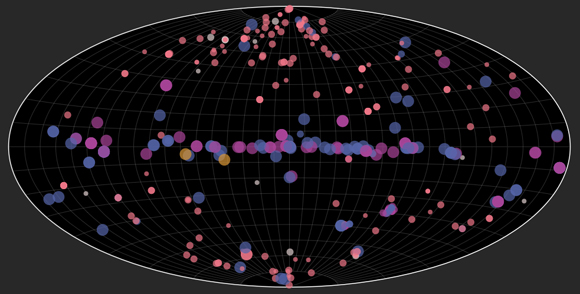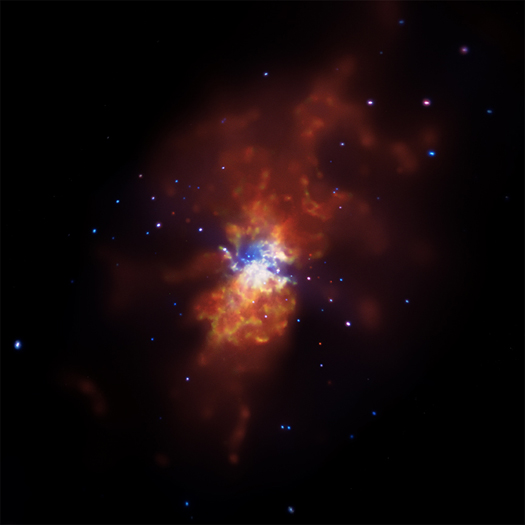Submitted by chandra on Thu, 2015-09-17 10:18
 Alicia Goldstein
Alicia GoldsteinWe welcome Alicia Goldstein, who was an intern at the Chandra X-ray Center this past summer, as our guest blogger. Ms. Goldstein, originally from Ellicott City, MD, is currently a senior at the University of Maryland, Baltimore County where she majors in mechanical engineering. Prior to this summer, Ms. Goldstein was an intern at NASA’s Goddard Space Flight Center and lists working for NASA as her ideal career goal.
This summer, I worked on two separate projects. The first involved the development of a Python code that would display the defined and predicted positions and velocities of Chandra, and the second involved the analysis of the periods of the variable stars in the Chandra Variable Guide Star Catalog,, or VGuide, database. The coding project involved interpreting and manipulating previous code, as well as creating entirely new sections. Given an input of two data files, the code was able to output a file with plots of the predicted and defined velocities and positions of the spacecraft.
Submitted by chandra on Tue, 2013-10-29 09:58
Submitted by chandra on Tue, 2013-10-01 17:31
American Archives Month (each October) is an exciting time around here. We spend a lot of time working through the Chandra archive to bring you the best and most interesting objects in the X-ray Universe that have made their way across space and time (via photons) to Chandra's detectors.

It has been a personal goal of mine, since taking this job as Chandra science imager about four years ago, to create an interactive tool for the public to engage with the Chandra archive of released imagery in a new and innovative way. For this to work, a few pieces of the puzzle had to fall into place.
Submitted by chandra on Tue, 2013-02-19 17:38
Joe DePasquale, Science Imager for NASA's Chandra X-ray Observatory, gives a pictorial tour behind the scenes on processing our latest Chandra press release image, supernova remnant W49B
I thought it might be useful to take a quick look at the various components that went into making the image for W49B. The release has sparked some attention and discussion on black holes, as well as how (and why) images such as these are colored. The processing of W49B included a combination of Chandra's CIAO software, PixInsight and Photoshop. The colors applied are representative, as we are translating something invisible to our eyes into something we can see. The image combines X-rays from NASA's Chandra X-ray Observatory in blue and green, radio data from the NSF's Very Large Array in pink, and infrared data from Caltech's Palomar Observatory in yellow. Enjoy, and feel free to ask any questions.
Submitted by chandra on Fri, 2013-01-25 07:45
This week marks a milestone in the openFITS collection as we've nearly doubled the amount of data offered up for curious minds to explore and create their own images. We now offer a collection of 17 data sets covering supernova remnants, galaxies, neutron stars, pulsars, and the supermassive black hole at the center of our very own galaxy, the Milky Way. Additionally, we've updated the openFITS overview and tutorials to reflect changes in the newest version of GIMP (v2.8), our choice of image processing platform for this project. GIMP v2.8 is now available as a native application on Mac OS X and offers some exciting new features as well as laying the groundwork for very exciting developments to come.

Submitted by chandra on Tue, 2011-10-11 11:11
October is American Archives Month—a time to celebrate the importance of archives across the country. In honor of Archives Month, we're participating in a pan-Smithsonian blogathon. Throughout October we, and other blogs from across the Smithsonian, will be blogging about Chandra's rich archive of astronomical data, issues, and behind-the-scenes projects.
----------------------------------------------------------------------------------------------------------------------------
Submitted by chandra on Fri, 2010-07-16 15:02
The openFITS project represents a step towards removing some of the mystery surrounding image processing of the X-ray data from the Chandra Observatory. As the Science Imager for Chandra, I'm often asked if astronomical objects appear in optical images as they would if we could somehow fly to these objects and view them with our own eyes. Of course, this is usually asked in relation to optical images, such as those from Hubble, because human eyes cannot actually see X-rays!